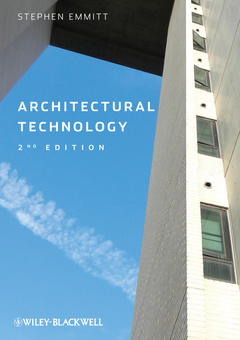Description
Architectural Technology (2nd Ed.)
Author: Emmitt Stephen
Language: English
Subject for Architectural Technology:
264 p. · 17.3x24.5 cm · Paperback
Description
/li>Contents
/li>Biography
/li>
The Second edition of Architectural Technology addresses these challenges directly. Much greater emphasis is given to the three core themes of the book - Environmental Sustainability; Innovation; and Design. An increase in the visual material included reinforces the critical role of Design, aiding students to better translate conceptual designs into built artefacts.
Building upon solid teaching practice from the previous edition, Architectural Technology is now more concisely structured to take the reader through the whole life cycle of a building, emphasising sustainability and building performance. Material on digital information, building information modelling (BIM) and information communication technologies has been updated. Most chapters have been re-titled to emphasise the importance of design and make the book more accessible to a wider range of students. Chapters conclude with updated/more extensive links to further reading.
Architectural Technology, 2nd Edition:
- Bridges the knowledge gap between design and construction
- Tackles the core subjects of management, technologies and design from a sustainable building angle
- Addresses the buildability and performance of a design from a whole life perspective
Thoroughly revised and updated this undergraduate level textbook is essential for Architectural Technology courses. Students studying Architectural Engineering, Architecture, Building Surveying; and more general Construction courses, will find the material invaluable.
Foreword – Colin Orr, President of CIAT ix
Introduction xi
1 Fundamentals 1
Sensory engagement 3
Building innovation 6
Building characteristics 10
Enclosure and functional requirements 14
Philosophies and approaches 19
Further reading 23
2 Physical Design Generators 25
The physical context: a sense of place 26
Micro climates and weathering 32
Structure and fabric 35
Materials 39
Services 43
Further reading 45
3 Social Design Generators 47
The social context 48
Communication and language 49
Design decisions 53
Risk 57
Quality 58
Added value 61
Further reading 63
4 Regulatory Design Generators 65
Town planning and development control 67
The building regulations 72
Standards and codes of practice 75
Trade associations 76
Testing and research reports 77
Further reading 79
5 Humane Design Generators 81
Perception of our buildings 82
Physiology and usability 85
Healthy environments 87
Safe environments 89
Secure environments 91
Fire safety 95
Further reading 98
6 Physical Interfaces 99
Typologies 101
Transitions 105
Joints and connections 111
Tolerances 114
Further reading 117
7 The Art of Detailing 119
Detailing principles 121
Environmental issues 127
Performance of the joint 131
Designing the details 134
Further reading 136
8 The Art of Specifying 137
Specification methods 138
Selection criteria – fitness for purpose 139
Writing the specification 146
Contents of a written specification 150
Further reading 152
9 The Art of Informing 153
Media 154
Coordinated project information 159
Drawings 162
Physical models 166
Bills of quantities 168
Digital information and virtual details 168
Information flow and design changes 170
Further reading 171
10 Assembling the Parts 173
The designer-contractor interface 174
Flows 176
Quality of work 180
Design changes 183
Practical completion and hand-over 186
Learning from building projects 187
Further reading 191
11 Living with Buildings 193
Durability and decay 194
Preservation, restoration, and conservation 200
Principles of conservation, repair and maintenance 204
Upgrading existing buildings 208
Learning from buildings 211
Further reading 212
12 Disassembly and Reuse 213
Reusing redundant buildings 214
Demolition and disassembly 218
Reclamation, reuse, and recycling 220
Stretching the tradition 222
Further reading 227
References 229
Index 235
These books may interest you

Architectural Graphic Standards 128.91 €

Architectural Graphic Standards 264.06 €


